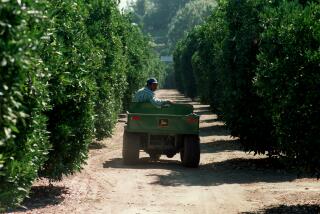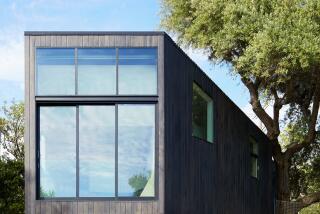Los Encinos to Showcase Life of 1870s
- Share via
Since it was built in 1872 by two French brothers, a simple two-story house at Los Encinos State Historical Park has served as a ranch house, a restaurant, a bordello and, for the last 45 years, a warehouse and pigeon coop.
On Sunday, the Garnier House in Encino began yet another life--this time as a museum showcasing the rugged life of San Fernando Valley rancheros in the 1870s.
About 75 people showed up to celebrate the reopening of the limestone house after more than a decade of planning and renovations to make the building safe in an earthquake. Docents dressed in period costumes and a group of history buffs from Ft. Tejon re-enacted the drills of Civil War soldiers.
The museum, which occupies a corner of the house, includes pictures, maps and hands-on displays of early California craftsmanship.
State Park Ranger Russ Kimura said he wants to restore the house’s kitchen to its original state and build archives on the upper floor, where ranch hands once slept.
“So much has been lost or destroyed,” said Michael Crosby, president of the Los Encinos Docent Assn. “It’s nice to know that at least these few buildings remain.”
The house, one of the oldest in the Valley, was built as a bunkhouse for ranch hands on Phillippe and Eugene Garnier’s expansive rancho, but had been used since 1947 as a warehouse because it was deemed unsafe for the public.
Money for renovations--about $175,000--came from the state Senate three years ago and steel reinforcements were installed.
The building joins the five-acre park’s adobe and blacksmith shop as an exhibit on early Valley history.
Together, the buildings and their exhibits describe a time when weary travelers on El Camino Real stopped for a 25-cent meal alongside the warm Encino pool, and the rolling floor of the Valley was “dotted at all times with wild long-horned Mexican cattle.”
Now, the honking of geese is interrupted by the honking of cars on Ventura Boulevard.
Most of what remains at Los Encinos was built by the Garniers, French Basque brothers who owned the rancho for a few years in the 1870s. They built the bunkhouse and blacksmith shop, put a pitched roof on the old adobe and capped the natural spring, digging a reservoir in the shape of a Spanish guitar.
The brothers invested thousands of dollars in new breeds of sheep and cattle, but went bankrupt after wool prices dropped dramatically and drought ravaged their herds in 1874-75. The brothers sold the rancho and later moved back to France.
The rancho dates to 1845 when Mexican Gov. Pio Pico granted three Indians the original 4,460-acre tract, bounded roughly by what is now Mulholland Drive, Sepulveda Boulevard, Vanowen Street and White Oak Avenue.
The Indians--Ramon, Francisco and Roque--held the land until Don Vicente de la Ossa bought a share four years later. He took total control in 1857.
Kimura did not know how much de la Ossa paid for the rancho, but speculated that it was not much.
De la Ossa played host at his eight-room adobe to travelers on their way to Santa Barbara.
His widow later sold the rancho to her son-in-law, Los Angeles County Sheriff James Thompson, for $3,500.
When the Garniers took over, they decided to make a profit off travelers once given shelter free of charge by de la Ossa, and opened a saloon and grocery in 1874.
With its meals a quarter and baths available, one traveler called the saloon “the most complete roadside inn in California.”
Completion of the Southern Pacific rail line through the Valley in 1876 reduced business from travelers on the stagecoach line, which stopped there.
In this century, the old bunkhouse was turned into a restaurant and speak-easy, where bathtub gin was served in a country setting. And some of the old ranch hands’ upstairs rooms were used by prostitutes to entertain their clients.
More to Read
Sign up for Essential California
The most important California stories and recommendations in your inbox every morning.
You may occasionally receive promotional content from the Los Angeles Times.










